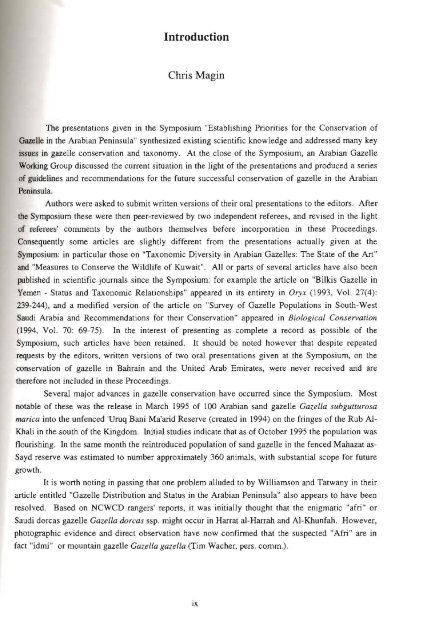CONSERVATION OF ARABIAN GAZELLES - Nwrc.gov.sa
CONSERVATION OF ARABIAN GAZELLES - Nwrc.gov.sa
CONSERVATION OF ARABIAN GAZELLES - Nwrc.gov.sa
Create successful ePaper yourself
Turn your PDF publications into a flip-book with our unique Google optimized e-Paper software.
Introduction <br />
Chris Magin<br />
The presentations given in the Symposium "Establishing Priorities for the Conservation of<br />
Gazelle in the Arabian Peninsula" synthesized existing scientific know ledge and addressed many key<br />
issues in gazelle conservation and taxonomy. At the close of the Symposium, an Arabian Gazelle<br />
Working Group discussed the current situation in the light of the presentations and produced a series<br />
of guidelines and recommendations for the future successful conservation of gazelle in the Arabian<br />
Peninsula.<br />
Authors were asked to submit written versions of their oral presentations to the editors. After<br />
the Symposium these were then peer-reviewed by two independent referees, and revised in the light<br />
of referees' comments by the authors themselves before incorporation in these Proceedings.<br />
Consequently some articles are slightly different from the presentations actually given at the<br />
Symposium: in particular those on "Taxonomic Diversity in Arabian Gazelles: The State of the Art"<br />
and "Measures to Conserve the Wildlife of Kuwait". All or parts of several articles have also been<br />
published in scientific journals since the Symposium: for example the article on "Bilkis Gazelle in<br />
Yemen - Status and Taxonomic Relationships" appeared in its entirety in Oryx (1993, Vol. 27(4):<br />
239-244), and a modified version of the article on "Survey of Gazelle Populations in South-West<br />
Saudi Arabia and Recommendations for their Conservation" appeared in Biological Conservation<br />
(1994, Vol. 70: 69-75). In the interest of presenting as complete a record as possible of the<br />
Symposium, such articles have been retained. It should be noted however that despite repeated<br />
requests by the editors, written versions of two oral presentations given at the Symposium, on the<br />
conservation of gazelle in Bahrain and the United Arab Emirates, were never received and are<br />
therefore not included in these Proceedings.<br />
Several major advances in gazelle conservation have occurred since the Symposium. Most<br />
notable of these was the release in March 1995 of 100 Arabian <strong>sa</strong>nd gazelle Gazella subgutturo<strong>sa</strong><br />
marica into the unfenced 'Uruq Bani Ma'arid Reserve (created in 1994) on the fringes of the Rub AJ<br />
Khali in the south of the Kingdom. Initial studies indicate that as of October 1995 the population was<br />
flourishing. In the <strong>sa</strong>me month the reintroduced population of <strong>sa</strong>nd gazelle in the fenced Mahazat as<br />
Sayd reserve was estimated to number approximately 360 animals, with substantial scope for future<br />
growth.<br />
It is worth noting in passing that one problem alluded to by Williamson and Tatwany in their<br />
article entitled "Gazelle Distribution and Status in the Arabian Peninsula" also appears to have been<br />
resolved. Based on NCWCD rangers' reports, it was initially thought that the enigmatic "afri" or<br />
Saudi dorcas gazelle Gazella dorcas ssp. might occur in Harrat ai-Harrah and Al-Khunfah. However,<br />
photographic evidence and direct observation have now confirmed that the suspected "Afri" are in<br />
fact "idmi" or mountain gazelle Gazella gazella (Tim Wacher, pers. comm.).<br />
IX
















